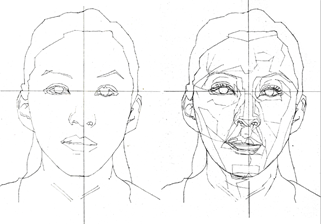Age progression portrait drawing to find missing people
##plugins.themes.bootstrap3.article.main##
Abstract
The yearly amount of Missing persons is a big issue in Mexico, just like the case of Perla Alondra Bolaños Cruz, who disappeared in 2014 when she was 22. One way to solve this problem is the missing person posters issued by civil and government associations. However, another problem is that missing people face's on these posters change their features over time. So, this investigation proposes the creation of an age progression portrait drawing. By making drawings out of photographs of both the missing person and their family members, and the study of the human face aging process. As a result, Perla Alondra's age progression portrait, as she would look in 2022, age 30. The association that issued Perla Alondra's first missing person poster, the AMNRDAC (as in Spanish, Mexican Association of Stolen and Disappeared Children Civil Association), already has this portrait to continue the investigation
##plugins.themes.bootstrap3.article.details##
As of Volume 11, Issue. 21, corresponding to the year 2024, this CC BY-NC 4.0 license replaces the one used in previous issues, namely CC BY-NC-SA 4.0

This work is licensed under a Creative Commons Attribution-NonCommercial 4.0 International License.
- Attribution — You must give appropriate credit , provide a link to the license, and indicate if changes were made . You may do so in any reasonable manner, but not in any way that suggests the licensor endorses you or your use.
- NonCommercial — You may not use the material for commercial purposes .
- No additional restrictions — You may not apply legal terms or technological measures that legally restrict others from doing anything the license permits.
- ShareAlike — If you remix, transform, or build upon the material, you must distribute your contribution under the same license as the original. NOTE: This point applies to numbers 1 to 20 of the magazine with the previous CC-BY-NC-SA 4.0 license. Does not apply to the new CC BY-NC 4.0 license from Volume 11, Number. 21 (2024).
References
-Adobe Inc. “El NCMEC redujo su tasa de rebote”. Recuperado de https://business.adobe.com/mx/customer-success-stories/national-center-for-missing-and-exploited-children-case-study.html
-Gibson, L. (2007). Forensic Art Essentials. Academic Press.
-Helfand, J. (2019). Face a visual Odyssey. The MIT Press. Recuperado de https://thereader.mitpress.mit.edu/the-troubling-pursuit-of-human-metrics/
-Parramón, J. M. (1967). Luz y sombra en dibujo artístico. España: Instituto Parramón.
-Taylor, K. (2000). Forensic art and illustration. CRC Press.

























